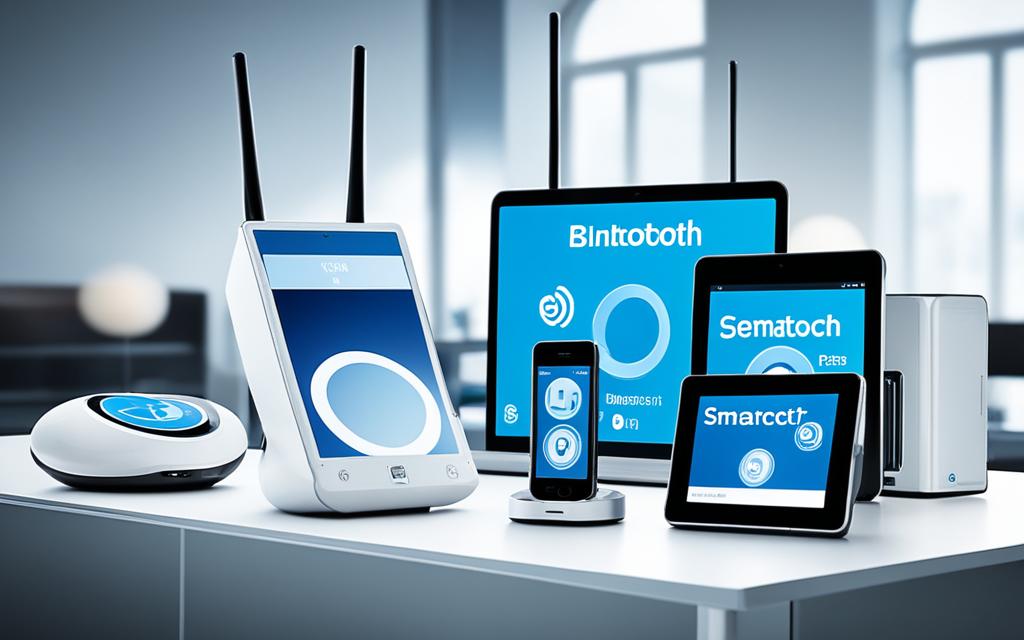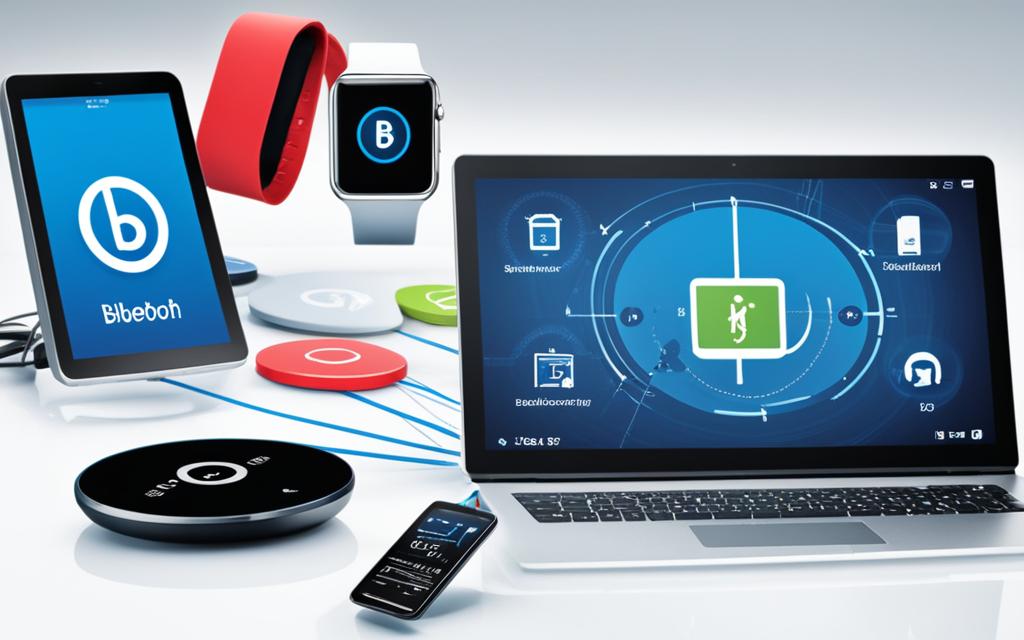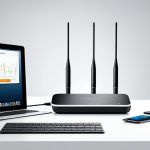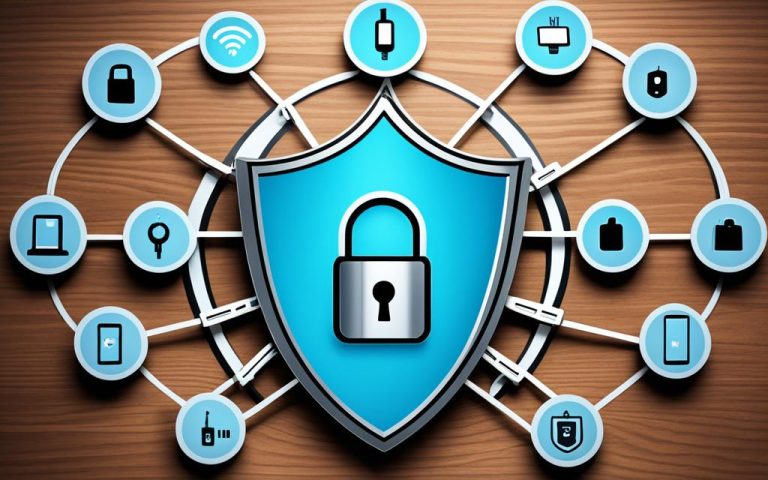Welcome to our informative article on Bluetooth technology and its role in Personal Area Networks (PANs). In today’s digital world, connectivity is paramount, and Bluetooth technology offers a seamless solution for connecting devices wirelessly within short-range networks. With PANs becoming increasingly prevalent, understanding the fundamentals of Bluetooth technology is essential.
Bluetooth technology serves as the backbone of many PANs, allowing electronic devices, such as smartphones, tablets, laptops, and printers, to communicate and exchange data effortlessly. PANs are designed to connect devices within a limited range of approximately 10 meters. They enable tasks like file sharing, internet access, and device synchronization, making them crucial for efficient workflow and productivity.
Bluetooth technology provides a wireless method of connectivity, eliminating the need for cumbersome cables and facilitating quick and hassle-free connections. The secure and efficient nature of Bluetooth ensures seamless communication and data transfer within PANs, offering convenience and flexibility for users.
Throughout this article, we will delve deeper into the workings of PANs, the core components involved, and the specific role Bluetooth technology plays in connecting devices. We will also explore the differences between wireless and wired PANs and discuss the subset of Bluetooth device networks within the broader PAN context.
So, let’s dive into the world of Bluetooth technology and discover how it enables seamless connectivity within PANs. But first, take a moment to appreciate the image below, which represents the power of Bluetooth technology in connecting devices within a PAN.
Defining Personal Area Network (PAN) and Its Core Components
A Personal Area Network (PAN) is a network that connects electronic devices within a short range, typically around an individual person’s workspace. PANs provide a convenient and efficient means of connectivity, enabling seamless communication and data exchange among electronic devices.
The core components of a PAN encompass:
- Electronic Devices: PANs connect a variety of electronic devices, such as smartphones, wearables, and computers. These devices form the foundation of a PAN network, facilitating communication and collaboration.
- Connectivity Medium: PANs utilize either wireless or wired connectivity mediums to establish connections between devices. Wireless PANs (WPANs) rely on technologies like Bluetooth and Wi-Fi, offering mobility and eliminating the need for physical cables. Wired PANs, on the other hand, leverage physical cables such as USB or Ethernet, ensuring stable connections and faster data transfer rates.
- Data Transmission Protocol: PANs employ specific data transmission protocols that define the rules and standards for communication and data exchange within the network. These protocols ensure seamless transmission of information between devices and enable efficient resource sharing.
- Network Security Measures: To safeguard the integrity and confidentiality of data within a PAN, network security measures are implemented. These measures include encryption, authentication, and access control mechanisms, protecting the network from unauthorized access and data breaches.
PANs serve as a foundation for seamless connectivity, enabling individuals to access and share resources efficiently. They play a crucial role in enhancing productivity and collaboration by fostering easy communication and data exchange among electronic devices.
Understanding the Workings of a PAN Network
A PAN network functions by creating a communication bridge between devices. This bridge enables seamless data exchange and communication within the network. For instance, a smartphone can connect to a laptop to transfer files or sync data.
This communication bridge is established through protocols that define the rules for data exchange. These protocols ensure that the transfer of information between devices is secure and efficient, allowing for smooth communication within the PAN network.
Within its range, a PAN network can support various tasks such as file sharing, internet access, and device synchronization. The capabilities of the PAN network depend on the devices connected and the technology utilized, enabling a tailored network that caters to specific business needs.

Benefits of a PAN Network
- Seamless Communication: PAN networks facilitate direct and instant communication between devices.
- Efficient Data Exchange: Data can be easily transferred and shared among connected devices.
- Reduced Wiring: PAN networks eliminate the need for extensive wiring, reducing clutter and improving mobility within the network.
- Increased Productivity: By enabling quick and easy connectivity, PAN networks enhance productivity by streamlining tasks and workflows.
“A PAN network acts as a communication bridge, allowing devices to interact and exchange data seamlessly.”
By creating a PAN network, organizations can foster better collaboration, enhance productivity, and streamline processes. Whether it’s sharing files, accessing the internet, or synchronizing devices, a PAN network simplifies communication and data exchange within a defined workspace.
The Role of Bluetooth in Personal Area Networks
Bluetooth technology is a cornerstone of many Personal Area Networks (PANs), providing a wireless method to connect devices over short distances. With its ability to create seamless connections, Bluetooth is ideal for scenarios where quick and cable-free connectivity is crucial.
Bluetooth technology offers numerous benefits within a PAN, including:
- Efficient and secure device communication
- Seamless data transfer
- Convenience and flexibility in connecting devices
For instance, Bluetooth allows users to connect wireless peripherals like mice, keyboards, and headsets to laptops or smartphones, enhancing productivity and convenience. The wireless nature of Bluetooth eliminates the need for tangled cables and enables a clutter-free workspace.
Bluetooth technology is the key driver behind the wireless connectivity experience in Personal Area Networks. Its ability to establish quick and secure connections between devices is unmatched, making it indispensable in modern PANs.
Bluetooth technology is versatile, supporting a wide range of devices and applications within a PAN. Whether it’s syncing a smartphone with a hands-free headset or sharing files between devices, Bluetooth ensures smooth and reliable communication.
Moreover, Bluetooth technology operates within a short-range, typically up to 10 meters, making it suitable for personal or small-scale networks. It also provides a secure connection, minimizing the risk of unauthorized access to sensitive information.
Bluetooth in PANs: A Visually Appealing and Interactive Example
Let’s take a closer look at how Bluetooth functions in a PAN network:
| Device | Function | Status |
|---|---|---|
| Smartphone | Acting as the central device, enabling internet access and file sharing | Connected |
| Laptop | Receiving internet access from the smartphone and sharing files | Connected |
| Wireless Headset | Providing hands-free communication with the smartphone | Connected |
| Wireless Mouse | Enabling convenient cursor control on the laptop | Connected |
| Printer | Printing documents wirelessly from the laptop | Connected |
This example demonstrates how Bluetooth technology enables seamless connectivity and efficient data exchange within a PAN. Each device can communicate and interact wirelessly, enhancing productivity and user experience.
Wireless vs. Wire: How PANs Differ in Connectivity
Personal Area Networks (PANs) offer different connectivity methods depending on whether they are wireless PANs (WPANs) or wired PANs. WPANs leverage technologies like Bluetooth and Wi-Fi, providing wireless connectivity for devices within a short range. On the other hand, wired PANs rely on physical cables such as USB or Ethernet to establish connections between devices.
Wireless PANs, with their cable-free nature, offer increased mobility and convenience. They eliminate the clutter of cables, allowing for greater flexibility and freedom of movement within the PAN. Wireless PANs, especially those using Bluetooth technology, enable seamless connections between devices, streamlining tasks like file sharing and device synchronization.
Alternatively, wired PANs generally provide faster data transfer rates and more stable connections. By using physical cables, wired PANs ensure a reliable and consistent flow of data. This can be beneficial for scenarios where speed and stability are a priority, such as transferring large files or streaming high-quality media.
Ultimately, the choice between wireless and wired PANs depends on the specific requirements and preferences of the user or business. Wireless PANs offer convenience and mobility, making them suitable for everyday tasks and scenarios. On the other hand, wired PANs provide faster data transfer rates and stability, making them ideal for applications that demand reliable and high-speed connectivity.
When deciding between wireless and wired PANs, it’s important to consider factors such as the nature of the tasks performed within the PAN, the distance between devices, and the need for mobility or stability. By understanding the differences in connectivity, users can make informed decisions when setting up their PANs to meet their unique needs.
Wireless PAN (WPAN) vs. Wired PAN Comparison:
| Wireless PAN (WPAN) | Wired PAN |
|---|---|
| Utilizes technologies like Bluetooth and Wi-Fi | Relies on physical cables such as USB or Ethernet |
| Offers mobility and freedom of movement | Provides faster data transfer rates |
| Eliminates the clutter of cables | Ensures more stable connections |
| Suitable for everyday tasks and scenarios | Ideal for applications requiring reliability and speed |
Bluetooth Device Networks as a Subset of Personal Area Networks
Bluetooth device networks are an integral part of Personal Area Networks (PANs), focusing on the seamless connection of peripherals such as keyboards, mice, and headsets to computers or smartphones. With Bluetooth technology, these devices can communicate securely and efficiently over short distances, making it an ideal choice for connecting peripheral devices within a PAN.
Bluetooth technology provides convenience, flexibility, and adaptability in connecting a diverse range of devices within a PAN. Whether it’s pairing a wireless keyboard to a laptop or connecting a headset to a smartphone, Bluetooth ensures a hassle-free and cable-free experience. This wireless connectivity enables users to work or play without the limitations of physical connections.
“The ability to connect peripherals wirelessly using Bluetooth technology enhances the mobility and usability of personal devices within a PAN. It simplifies the way we interact with our devices, streamlining productivity and enhancing our overall user experience.”
Bluetooth device networks offer a wealth of benefits, including:
- Flexibility: With Bluetooth, users can connect multiple peripherals to a single device, allowing for seamless task-switching and multitasking.
- Interoperability: Bluetooth is widely supported by various devices and operating systems, ensuring compatibility and easy integration.
- Energy efficiency: Bluetooth technology is designed to be energy-efficient, maximizing battery life for both the peripheral devices and the host device.
By leveraging Bluetooth technology, PANs can be expanded to include a wide variety of peripheral devices, enabling users to personalize their connected experience and achieve greater efficiency in their daily tasks.
Benefits of Bluetooth Device Networks in PANs
Bluetooth device networks in PANs offer several advantages:
- Convenience: Bluetooth eliminates the need for tangled wires and cables, providing a clutter-free workspace and enhanced user mobility.
- Ease of use: Bluetooth connections are seamless and user-friendly, taking the hassle out of complex setup processes.
- Security: Bluetooth offers secure and encrypted communication, ensuring that sensitive data transmitted between devices remains protected.
- Versatility: Bluetooth supports a wide range of peripheral devices, allowing for the connection of keyboards, mice, headsets, speakers, and more.
Bluetooth device networks play a critical role in enhancing the functionality and usability of Personal Area Networks (PANs). With their ability to connect peripherals seamlessly and efficiently, Bluetooth technology empowers users to create a personalized and interconnected ecosystem of devices within their PAN. As technology continues to evolve, Bluetooth device networks are poised to become even more essential in facilitating seamless connectivity and enhancing the overall user experience.
Conclusion
Bluetooth technology is a vital component in facilitating seamless connectivity within Personal Area Networks (PANs). PANs serve as networks that connect electronic devices within a short range, offering a convenient and efficient means of communication and data exchange. With Bluetooth as a cornerstone technology in PANs, devices can be wirelessly connected over short distances, allowing for quick and hassle-free connections.
PANs can support a variety of essential tasks, including file sharing, internet access, and device synchronization. Bluetooth technology enables secure and efficient communication between devices, ensuring the smooth transfer of data within PANs. Such wireless connectivity has become an indispensable feature in modern PANs, as it allows for seamless connectivity and enhances productivity for businesses and individuals alike.
As technology continues to evolve, Bluetooth and PANs are poised to play a pivotal role in shaping the future of connectivity. With their ability to provide seamless and wireless connections, Bluetooth-enabled PANs offer convenience, flexibility, and adaptability for connecting a wide range of devices. As such, we can expect Bluetooth technology to remain an essential component in PANs, driving innovation and enhancing connectivity in various spheres like home automation, healthcare, and smart cities.
FAQ
What is Bluetooth technology and how does it relate to PANs?
Bluetooth technology is a wireless method of connecting devices over short distances. It plays a crucial role in connecting devices within Personal Area Networks (PANs), facilitating seamless communication and data exchange.
What are Personal Area Networks (PANs) and what are their core components?
PANs are networks that connect electronic devices within a short range, typically around an individual person’s workspace. The core components of a PAN include electronic devices such as smartphones, wearables, and computers, a connectivity medium (wireless or wired), a data transmission protocol, and network security measures.
How does a PAN network function?
A PAN network creates a communication bridge between devices, allowing for tasks such as file sharing, internet access, and device synchronization. This communication is achieved through protocols that define the rules for data exchange, ensuring seamless communication.
What role does Bluetooth play in Personal Area Networks?
Bluetooth technology is a cornerstone of many PANs, offering a wireless method to connect devices over short distances. It provides a secure and efficient way to connect devices, enabling seamless communication and data transfer.
How do wireless and wired PANs differ in connectivity?
Wireless PANs (WPANs) use technologies like Bluetooth and Wi-Fi, while wired PANs rely on physical cables such as USB or Ethernet. Wireless PANs offer mobility and eliminate cable clutter, while wired PANs generally provide faster data transfer rates and more stable connections.
What are Bluetooth device networks and how do they relate to PANs?
Bluetooth device networks are a subset of Personal Area Networks, focusing on connecting peripherals such as keyboards, mice, and headsets to computers or smartphones using Bluetooth technology. Bluetooth allows for secure and efficient communication between devices over short distances, making it ideal for connecting peripherals within a PAN.
How does Bluetooth technology contribute to seamless connectivity in PANs?
Bluetooth technology is a crucial component of PANs, providing a wireless method for connecting devices and enabling tasks such as file sharing, internet access, and device synchronization. It ensures secure and efficient communication, making it an essential part of modern PANs.




















Hi there,
We run an Instagram growth service, which increases your number of followers both safely and practically.
– Guaranteed: We guarantee to gain you 300-1000+ followers per month.
– Real, human followers: People follow you because they are interested in your business or niche.
– Safe: All actions are made manually. We do not use any bots.
The price is just $60 (USD) per month, and we can start immediately.
If you are interested, and would like to see some of our previous work, let me know and we can discuss further.
Kind Regards,
Megan
Unsubscribe here: https://removeme.click/unsubscribe.php?d=technetworks.ca
Most of us like to partake in a little vino, a cocktail, or a nice cold brewski every now and then…
And I’m one of them 🙂
However, recent studies prove the #1 sign you drink too much is excess lower belly fat (also referred to as “Liver Belly”).
That’s because the entire fat-burning process depends on a healthy liver.
And although alcohol is normally quite damaging to your liver…
The ancient Mediterranean ritual you’ll see at the link below naturally protects, purifies, and rapidly cleanses your liver of EVERY form of alcohol…
Allowing you to enjoy a few drinks while promoting weight loss at the same time!
That’s why, if you’re gonna drink alcohol, just follow this simple Mediterranean Ritual beforehand (takes 30 seconds).
Check it now: https://tinyurl.com/mediteraneanritual